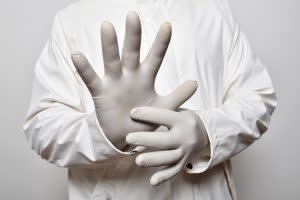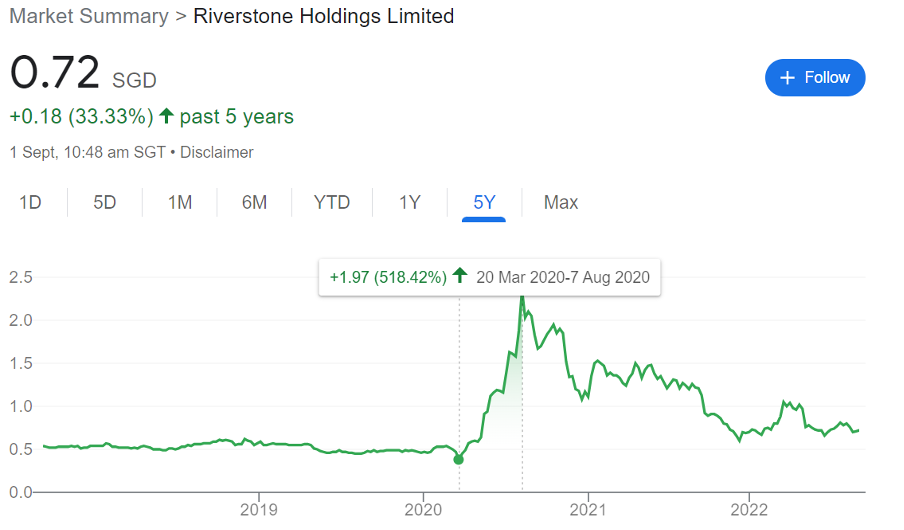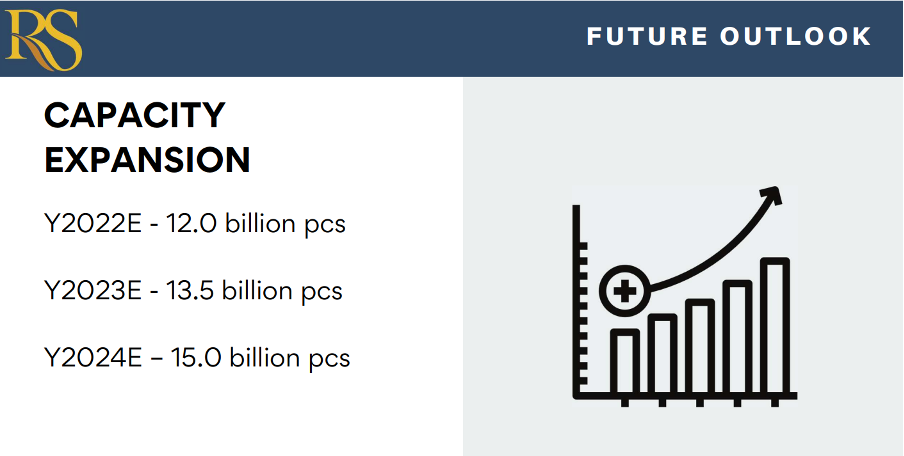Wrapping Our Heads Around Singapore-Listed Glove Stocks (Riverstone; Top Glove; UG Healthcare)

The Singapore Exchange is home to three established glove manufacturers – Riverstone Holdings Limited (SGX: AP4), Top Glove (SGX: BVA) and UG Healthcare Corporation Ltd (SGX: 8K7).
Glove manufacturers benefitted greatly during the onset of the Covid-19 pandemic.
For instance, Riverstone saw its share price soar over 500% from end-March to early August 2020 during the pandemic’s peak, before declining in recent times as the world opened up and learnt how to live with the virus.

Source: Google Finance
With the sudden demand for glove stocks evaporating, is it still worth looking into the glove companies over the long term?
Let’s get some clues from the companies’ latest financial results in this week’s edition of 4 Stocks This Week.
Riverstone Holdings (SGX: AP4)
Riverstone (SGX: AP4), which started in 1989, manufactures nitrile and natural rubber clean room gloves used in highly controlled and critical environments as well as premium nitrile gloves used in the healthcare industry. On top of gloves, it also produces finger cots, cleanroom packaging bags, and face masks.
Its six manufacturing facilities in Malaysia, Thailand, and China collectively produce 10.5 billion gloves annually.
For Riverstone’s first half ended 30 June 2022, revenue slumped 62.6% year-on-year to RM 754.3 million. The company said that it produced a lower quantity of products due to the recovery of the general market back to pre-COVID-19 demand levels. With that, Riverstone’s net profit plunged 79.9% to RM 208.9 million.
However, the company maintained its interim dividend of 10.00 sen per share to reward shareholders for their support.
Riverstone ended the 2022 first half with a cash balance of RM 574.6 million with negligible borrowings. Its strong balance sheet would enable the company to tide through the temporary tough time it’s seeing now.
Wong Teek Son, Riverstone’s executive chairman and chief executive, explained the situation it’s facing in the medical glove sector:
“The medical glove industry is currently undergoing a normalization trend with demand and ASPs [average selling prices] coming off COVID-19 highs. The extensive investment in production expansion from the investments made by the market and new players during the COVID-19 peaks has resulted in a current oversupply of gloves and inventory. The Malaysian Rubber Glove Manufacturers Association has lowered their projected global demand for rubber gloves for 2022 by 12%, confirming the short-term challenges of the industry in Malaysia.”
Despite the normalisation of demand, Riverstone is continuing on its planned expansion to increase its production capacity to 12.0 billion gloves by the end of 2022. Over the longer term, it envisions its capacity to grow to 15.0 billion pieces by 2024.

Source: Riverstone 1H 2022 corporate presentation
At Riverstone’s share price of S$0.72, it has a price-to-earnings (P/E) ratio of 6x and a dividend yield of 16.3%.
Top Glove (SGX: BVA)
Top Glove (SGX: BVA), which was founded in 1991, caters to the medical, food and general industrial sectors, and exports its gloves to 195 countries worldwide.
Top Glove saw its revenue fall 65% year-on-year to RM 1.47 billion and its net profit plunge 99% to just RM 15 million for the third quarter ended 31 May 2022.
The company said that on top of the normalisation of glove demand, headwinds such as global inflation, higher crude oil, and Malaysia’s minimum wage implementation that came into effect on 1 May 2022 are affecting its overall business.
However, Top Glove sees the current situation as a temporary setback and that challenges are part of doing business. It said it has successfully weathered many of such cycles since commencing operations 31 years ago.
It also added that it believes that the outlook for the glove industry is still promising as gloves remain an essential item in the healthcare sector. Glove demand will keep growing with increased usage from emerging markets where the glove consumption base is relatively low, coupled with higher levels of hygiene and health consciousness in a post-pandemic era.
Furthermore, the company is looking west towards the US to grow its business further.
Top Glove last traded at a share price of S$0.255, which translates to a P/E ratio of 9x and a dividend yield of 53%.
UG Healthcare (SGX: 8K7)
UG Healthcare (SGX: 8K7) sells gloves under the UNIGLOVES brand through an extensive network of distribution companies.
For its financial year ended 30 June 2022 (FY2022), UG Healthcare’s revenue fell 31.3% year-on-year to S$232.6 million, while its net profit tumbled 69% to S$36.8 million.
Similar to Riverstone and Top Glove, UG Healthcare was affected by glove demand worldwide suddenly tapering off as more countries progressed from the pandemic to the endemic phase.
Despite the lower profitability in FY2022, UG Healthcare’s total dividend for the year rose to 0.64 Singapore cents per share, up 4.7% from 0.611 cents per share last year.
Looking ahead, UG Healthcare said:
“Amid the disequilibrium in the demand-supply of disposable gloves, the global economic slowdown and geopolitical uncertainties, the Group remains mindful of further expansion in disposable gloves production beyond its current total installed production capacity of 4.6 billion pieces per annum in the near future. Nevertheless, the Group is confident that its current total installed production capacity is adequate to satisfy the demand for its proprietary UNIGLOVES® branded disposable glove products.”
Gloves Remains Important In A Post-Pandemic World
We can see that glove manufacturers had a tough time coping with the mismatch of demand and supply as Covid-19 vaccination rates increased, allowing us to move into an endemic phase.
Having said that, the pandemic has also shown us the need for strict hygiene measures to prevent diseases from spreading. Therefore, even though there will be a normalisation of glove demand, glove manufacturers that have a high market share and resilient balance sheets should continue doing well over the long run as we can’t run away from using gloves in settings such as hospitals and cleanrooms.
You might have also noticed that the P/E ratios of the glove companies mentioned above are low, with their corresponding dividend yields being high. This is because the valuation metrics are backward-looking. Those figures could normalise as well as the companies run through a couple of more quarters. So, investors shouldn’t invest in a glove company just because its valuation looks enticing.
This article was written by Sudhan P, an investment analyst who is an avid investor of businesses listed on the stock market for over a decade now and is a huge advocate of investor education.
The post Wrapping Our Heads Around Singapore-Listed Glove Stocks (Riverstone; Top Glove; UG Healthcare) appeared first on DollarsAndSense.sg.

 Yahoo Finance
Yahoo Finance 